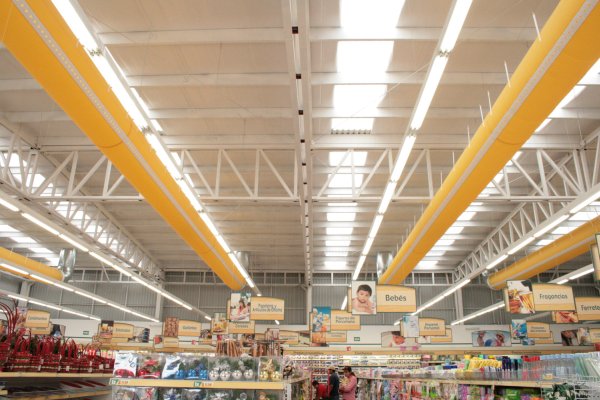
Areas of Use for Textile Air Ducts
Textile air ducts are critical components in HVAC (Heating, Ventilation, and Air Conditioning) systems for air distribution. In both commercial and industrial applications, textile air ducts serve various functions and play a crucial role in creating energy-efficient and comfortable environments. Proper selection and efficient use of these ducts regulate airflow within buildings, improve air quality, and enhance the overall efficiency of HVAC systems.
What Are Textile Air Ducts?
Textile air ducts are flexible air distribution systems made from woven or nonwoven fabrics. Compared to traditional materials like metal and PVC, these ducts are lighter, more flexible, and typically provide quieter airflow. Textile air ducts offer low resistance even at high airspeeds and can be easily shaped. They are simple to install and can be mounted quickly.
Textile air ducts help deliver air effectively and, unlike conventional ducts, direct the airflow smoothly to increase system efficiency. Used for both cooling and heating, textile air ducts provide low energy consumption and assist in improving indoor air quality.
Working Principle of Textile Air Ducts
The primary function of textile air ducts is to distribute the air used in HVAC systems effectively. Air moves through these ducts at a defined velocity and is released at designated points based on the duct design, allowing for optimal airflow in the target areas. Due to their flexible structure, textile ducts can easily adapt to the architectural requirements of buildings, unlike rigid metal ducts.
One of the key features of textile ducts is their ability to regulate airflow and ensure even distribution. This is particularly beneficial in large spaces like factories, offices, or shopping malls, where temperature balancing and energy savings are essential.
Application Areas of Textile Air Ducts
-
Large Commercial Buildings and Shopping Centers
In large commercial buildings and shopping centers, efficient management of high airflow is critical. Textile air ducts offer several advantages over traditional systems in such environments. They provide more balanced air distribution, reduce energy consumption, and create a more comfortable indoor atmosphere.
-
Comfortable Environments:
Textile air ducts ensure efficient operation of ventilation systems while providing quieter airflow. This is particularly beneficial in commercial spaces such as offices or shopping centers, where minimizing noise contributes to user comfort. -
Energy Savings:
The low-resistance design of textile ducts helps HVAC systems consume less energy. This reduces operational costs and supports energy efficiency within buildings.
-
Factories and Industrial Facilities
In industrial plants, especially on production lines, textile air ducts play a key role in directing airflow and improving workplace air quality. In environments where various materials and chemicals are processed, maintaining clean and healthy air is vital for both worker safety and productivity.
-
Offices and Residential Buildings
In offices and homes, balanced airflow directly impacts indoor comfort levels. Textile air ducts operate more efficiently and quietly, enhancing quality of life in residential and working environments.
-
Zoning and Comfort:
In offices with central ventilation systems, different rooms often have varying heating and cooling needs. Textile air ducts help balance temperature distribution across independently controlled zones. -
Energy Efficiency:
These ducts provide effective ventilation with lower energy consumption, reducing operational costs and offering an environmentally friendly solution.
Textile air ducts are essential components that enhance the efficiency of HVAC systems, ensure comfort, save energy, and improve air quality. With a wide range of applications—from industrial facilities to commercial buildings, and from residences to office environments—these ducts are indispensable to modern HVAC systems thanks to their flexible structures, energy efficiency, and quiet operation. Properly designed and implemented textile air ducts increase user comfort while contributing to environmental sustainability through energy savings. For these reasons, textile air ducts play a significant role in optimizing HVAC systems.
Ilker KURAN
Alperen Engineering Ltd.







